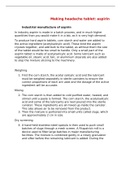Unit 4c making aspirin Study guides, Revision notes & Summaries
Looking for the best study guides, study notes and summaries about Unit 4c making aspirin? On this page you'll find 22 study documents about Unit 4c making aspirin.
All 22 results
Sort by
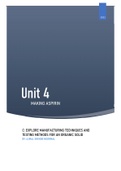
-
BTEC Applied Science Unit 4 Assignment C
- Essay • 22 pages • 2022
- Available in package deal
-
- £5.99
- 14x sold
- + learn more
This is the third assignment of Unit 4 in BTEC Applied Science Course which covers the report for the preparation of Aspirin. It was awarded a DISTINCTION.
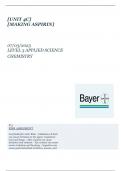
-
Unit 4 aim C applied science BTEC up to Distinction level
- Essay • 29 pages • 2024
-
- £7.36
- + learn more
This Unit 4C assignment was awarded DISTINCTION. The assignment contains all the criteria to achieve the highest grade. It also contains a list of accredited references. The TURNITIN similarity report for this assignment is of 11%
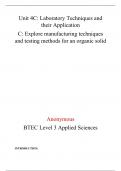
-
Unit 4C: Explore manufacturing techniques and testing methods for an organic solid
- Essay • 12 pages • 2024
- Available in package deal
-
- £7.66
- + learn more
Aspirin is a generic term for acetylsalicylic acid. This substance was first introduced in the late 1890s, that has become a ‘’non-steroidal anti-inflammatory drug’’, non-opioid analgesic and antiplatelet drug which is widely used for medicinal purposes. Aspirin will not react against the acetic conditions of the stomach, yet it is hydrolysed in the intestines as it will react on alkaline conditions to create ethanoate ions and salicylate. Aim: In this practical, an Aspirin will be made...
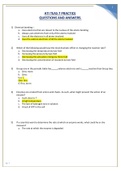
-
ATI TEAS 7 PRACTICE QUESTIONS AND ANSWERS
- Exam (elaborations) • 48 pages • 2023
-
- £13.77
- + learn more
ATI TEAS 7 PRACTICE QUESTIONS AND ANSWERS. 1) Chemical bonding – a. Uses electrons that are closest to the nucleus of the atoms bonding b. Always uses electrons from only of the atoms involved c. Uses all the electrons in all atoms involved d. Uses the valence electrons of all the atoms involved 2) Which of the following would have the most dramatic effect in changing the reaction rate? a. Decreasing the temperature by two-fold b. Increasing the pressure by two-fold c. Decreasin...
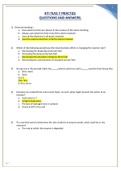
-
ATI TEAS 7 Practice Questions and Answers Chemistry (Best Guide for Teas 7 prep)
- Exam (elaborations) • 48 pages • 2023
-
- £9.31
- + learn more
ATI TEAS 7 PRACTICE QUESTIONS AND ANSWERS. 1) Chemical bonding – a. Uses electrons that are closest to the nucleus of the atoms bonding b. Always uses electrons from only of the atoms involved c. Uses all the electrons in all atoms involved d. Uses the valence electrons of all the atoms involved 2) Which of the following would have the most dramatic effect in changing the reaction rate? a. Decreasing the temperature by two-fold b. Increasing the pressure by two-fold c. Decreasin...
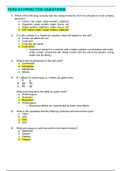
-
ATI TEAS Practice Question and Answers Latest Update (Graded A )
- Exam (elaborations) • 25 pages • 2020
- Available in package deal
-
- £8.50
- 1x sold
- + learn more
TEAS ATI PRACTICE QUESTIONS 1) Which of the following correctly lists the cellular hierarchy from the simplest to most complex structure? a. Tissue, cell, organ, organ system, organism b. Organism, organ system, organ, tissue, cell c. Organ system, organism, organ, tissue, cell d. Cell, tissue, organ, organ system, organism 2) If a cell is placed in a hypertonic solution, what will happen to the cell? a. It does not affect the cell b. It will swill c. It will stay the same d. It wi...
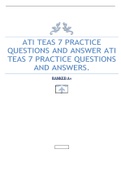
-
ATI TEAS 7 PRACTICE QUESTIONS AND ANSWER ATI TEAS 7 PRACTICE QUESTIONS AND ANSWERS
- Exam (elaborations) • 49 pages • 2023
-
- £15.39
- + learn more
ATI TEAS 7 PRACTICE QUESTIONS AND ANSWER ATI TEAS 7 PRACTICE QUESTIONS AND ANSWERS. RANKED A+ ATI TEAS 7 PRACTICE QUESTIONS AND ANSWERS. 1) Chemical bonding – a. Uses electrons that are closest to the nucleus of the atoms bonding b. Always uses electrons from only of the atoms involved c. Uses all the electrons in all atoms involved d. Uses the valence electrons of all the atoms involved 2) Which of the following would have the m...
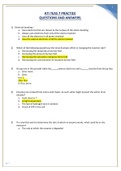
-
ATI TEAS 7 PRACTICE QUESTIONS AND ANSWERS LATEST TEST
- Exam (elaborations) • 48 pages • 2023
-
- £13.37
- + learn more
ATI TEAS 7 PRACTICE QUESTIONS AND ANSWERS. 1) Chemical bonding – a. Uses electrons that are closest to the nucleus of the atoms bonding b. Always uses electrons from only of the atoms involved c. Uses all the electrons in all atoms involved d. Uses the valence electrons of all the atoms involved 2) Which of the following would have the most dramatic effect in changing the reaction rate? a. Decreasing the temperature by two-fold b. Increasing the pressure by two-fold c. Decreasin...
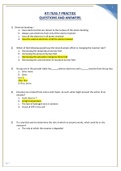
-
ATI TEAS 7 PRACTICE QUESTIONS AND ANSWERS LATEST 2023/2024
- Exam (elaborations) • 48 pages • 2023
-
- £13.53
- + learn more
ATI TEAS 7 PRACTICE QUESTIONS AND ANSWERS. 1) Chemical bonding – a. Uses electrons that are closest to the nucleus of the atoms bonding b. Always uses electrons from only of the atoms involved c. Uses all the electrons in all atoms involved d. Uses the valence electrons of all the atoms involved 2) Which of the following would have the most dramatic effect in changing the reaction rate? a. Decreasing the temperature by two-fold b. Increasing the pressure by two-fold c. Decreasin...

